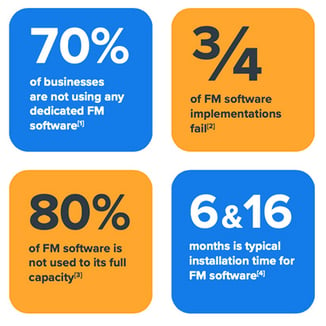Let’s be honest. The track record of most FM software actually delivering on its promise of organisational change is not great. So, what’s the problem?
There’s something that many FM software suppliers don’t want to talk about. Quite a lot of FM software implementations fail.

And when you break it down, the charge sheet against FM software is depressingly familiar.
- “CAFM solutions are unnecessarily complicated.”
- “They take ages to implement”
- “The team won’t use it”
- “Contractors won’t play ball”
- “We were being charged for features we weren’t even using”
With this kind of reaction, CAFM often slips into disuse and contracts are not renewed. Those that stay the distance often are only being used at a fraction of their capacity. After the effort of a difficult initial implementation and training - maybe the company can’t face the prospect of adding more complexity.
These are the stories we often hear from FMs, but for obvious reasons, vendors are reluctant to tell you about them.
7 reasons FM software fails
- Too Complicated - It’s a fact that many solutions take many months to install and require extensive training. They may come with IoT integrations and AI applications that promise to revolutionise the way you work, but these can drag out delivery times, while you lose the appetite for change. Overselling functionality, packing FM software with features and launching them all at once. It’s a recipe for an unsuccessful implementation. We think there’s a better way to manage this.
- “Too much clicking” Usability can be a huge hurdle for the poor adoption rate of CAFM software. Many offerings are focused on features and functionality at the expense of UX (user experience). You should beware of any systems that require huge amounts of training for your team before they can be used. Amazon, Facebook and LinkedIn don’t require extensive training for their users, and neither should a CAFM interface. The quality of the interface and the navigation should be a high priority in selecting FM software. Here are three places usability counts in a CAFM platform.
- “Contractors won’t play ball.” When you introduce a new piece of software to your contractors there’s always the danger of a bit of resistance. But if you’re expecting contractors to use your new solution - the least you can do is ensure it’s mobile-friendly and does what they need it to do. Otherwise, you’re not going to be able to collect the data you need and control the processes you need to. A CAFM solution has to make everyone’s life easier (including all your partners) if it’s going to be a success and not be ‘dead on arrival’.
- "They won't integrate" Dispersed systems that don’t communicate will only cause friction. The last thing businesses want to be doing is double or even triple handling data. One of the toughest challenges facilities teams face is volume and scale, which then puts pressure on the whole operation and support network around it. This is particularly challenging for finance and accounting teams, who are managing all the related quotes, purchase orders and invoices. They don’t need the hassle of having to learn and handle yet another software system. Equally, contractors do not want to be submitting quotes or invoices twice to different departments. If this isn’t tackled early on, teams can become sick of rhe extra work and wish they hadn’t bothered at all.
- "They’re too expensive". It’s true. There’s often a lack of transparency around costs in the FM marketplace. When you start adding in license fees for all your workers and contractors, costs can quickly mount up. And what about those hidden charges for account management, additional modules and reports? Businesses need to go into CAFM contracts with confidence around the pricing structure. So we’ve written a short piece here about what should you expect for your money.
- "They’re inflexible" Many companies will often go to large and long-established FM software providers because size and reputation breeds confidence. However, in the end these big software houses may not offer the flexibility you need as you address your specific business challenges. A large, global software supplier may not be interested in changing the way their systems work to accommodate one client. And you may soon find yourself frustrated by a lack of support.
- "They offer no support at all" Meanwhile, smaller scale, more DIY solutions without dedicated account management teams, can leave users with nothing but a software package, a monthly fee and a lasting sense of regret.
Faced with these kinds of obstacles, patchy user experience, as well as the dizzying range of options and charging structures, it’s no wonder so many FMs are wary of embarking on new CAFM projects. And when they find a solution that can just about do the job - there’s often a temptation to keep on with the contract, even though they’re not getting the value they should from the system.
Even so, the pressures and costs of maintenance management and compliance just keep mounting up for FMs - and a new phase of digital transformation remains on the agenda for most.
Is it time to choose?
But, how should you go about choosing the right fit FM software to make this transformation happen? Are you even clear about whether you need a CAFM or should be considering a switch right now?
That’s why we’ve written our free and comprehensive guide to choosing FM software.
It’s packed with tips and insights on how to procure the best solution while avoiding common pitfalls.
Because there are 100s of FM software packages out there to choose from, but they’re not all created equal.
What should they cost? What features should they contain? How long will they take to set up? And what support should you expect from your supplier?
Read our 3 step guide to choosing a right fit CAFM system to find out.
.png?width=680&height=700&name=Ai%20page%20module%20(2).png)


